Leg #2, Tahiti to Hawaii
See leg one (San Francisco to Tahiti) and three (Hawaii to San Francisco single-handed)
Outboard drama and new crew
May 16, 2024
So, the good news is that we now have a new propeller for the outboard. Gurney arrived from the US and brought a brand-spanking new, OEM, in-the-box propeller. The bad news is that… we no longer have a propellor spacer with which to mount that propeller. While I was taking off the old prop, I dropped the spacer into 40-feet of water. I nice guy from another boat spent 30 minutes diving looking for the spacer, to no avail. I was able to jury rig a stack of washers to take the place of the spacer, but it leaves one end if the drive shaft poorly supported. So, just like before we had the new prop, we’re only using the outboard at low RPM. We take the slow boat into town. We smile and wave at every vessel as it passes us.
We’re leaving Tahiti (and French Polynesia) tomorrow. We spent the last few days working on the boat (changing the oil, re-wiring the wind generator), and inspecting the key systems. We’ll be sailing about 2300 nautical miles. There are a few islands between Tahiti and Hawaii (Christmas Island, Kiribati) so we could divert in an emergency). Still, this is a serious passage and we need a high level of self-sufficiency. I think the boat is ready.
The challenge of this passage is wind angle. Sailboats can make way upwind, but they are a lot slower AND a lot less comfortable. In 20 knots of wind, Little My can make 8 or 9 knots downwind. And if we’re making that speed downwind, our speed is subtracted from the wind we feel (the apparent wind). So in 20 knots, we might only feel 12 knots of apparent wind passing the boat. The boat wound be mostly upright. There would not be undue stress on the rig of the crew. In 20 knots upwind, in contract, we can make maybe 4 or 5 knots. That means we’re experiencing 25 knots of apparent wind. The sails need to be heavily reefed. The boat heels over 25 degrees and smashes through waves. Things break.
Our course to Hawaii has the potential to leave us with a 1000-mile upwind sail from the equator. To avoid this, we need to not simply sail a direct line. Rather, we need to sail north east from Tahiti to the equator (which should be about a beam reach in the southern trade winds). This in turn will open up an about-beam course to Hawaii. In theory. The problem is, the southern trades sometimes rotate to the east or north east (making it hard for us to make the easting we need). Also, there’s a prevailing current running from the east to the west, also making our job harder.
I’m in touch with a boat that left a few days ago on the same course. They’ve been making good easting. And the forecast is for non-rotated trades winds for the next 5 days. They are a little strong (20 knots), but I think this is as good a weather window as we are likely to get.
Gurney (my brother) is excited to experience the ocean. I hope the straight-into-20-knot start does not rattle him.
-Ammon
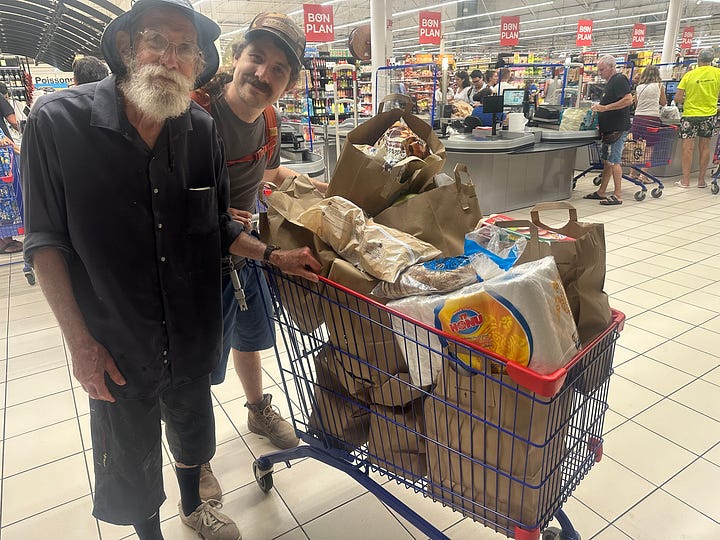
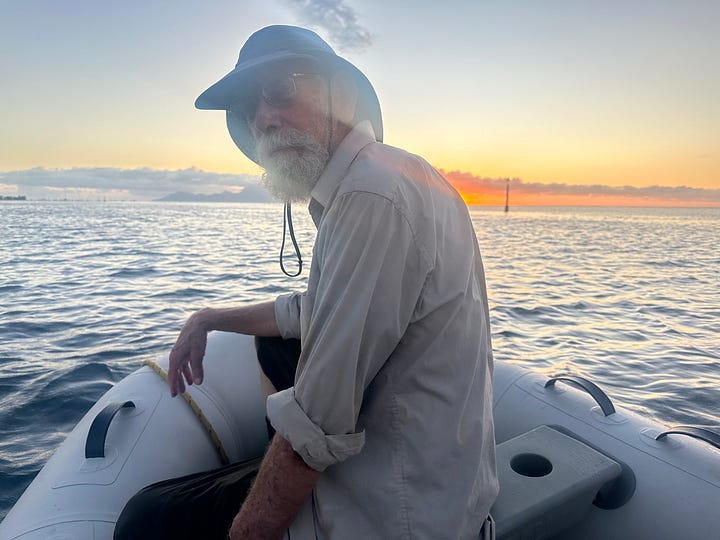
Departure and storm sails
May 18, 2024
15°09’S 148°56’W
We’re off! We departed yesterday afternoon. There was a small hiccup with the port clear-out process (I’d done what immigration needed me to do, but it ended up there was an entire other process I was supposed to do to notify the port of Papeete that we were leaving). Taking a boat in / out of a foreign country exposes one to a level of paperwork that I’ve not seen elsewhere. You go through the same process as 900-foot cargo vessels or 800-person cruise ships. It briefly looked like we might be stuck over the weekend. Buy all the officials were actually really nice and rushed to get us cleared out yesterday afternoon). So we sailed out of the Papeete reef pass right at sundown…
…straight into 25 knot winds. As we were sailing out (but still behind the protection of the island) a boat came CCD on with a 3rd reef in its mainsail (reducing the sail down to a small fraction of its size). I knew then we were in for some wind.
We put two reefs in our main, and chose to raise our storm jib (rather than unfurling our regular genoa). You can just roll a roller-furling genoa down to a tiny size, but this gives you a more distorted airfoil compared to a dedicated small sail. This is especially imported of you want to point well (fail upwind). You also don’t have to worry about the furling line breaking and suddenly unfurling the entire, enormous sail (as already happened once on this trip)
It took me a while to get this all rigged (it was our first time using the storm sail on the trip). We’re lucky to have a storm jib that we can fly on our inner forestay (without taking down the regular genoa)
It was aggressive conditions. Stuart, Gurney and I all felt sick. And Stuart had until this point been bulletproof. We were briefly concerned he might have a concussion (rather than sea sickness) because he had hit his head earlier. But in the end, there were no headache or light sensitivity symptoms, and sleep seemed to cure him (as is normal for seasickness).
Our re-wired wind generator is doing great in the strong winds. It’s been heavily overcast all day, but the batteries are charged.
Conditions have mellowed a bit and are forecast the mellow more tonight. Gurney and I are playing chess. We’re going to cover about 160 nautical miles in our first 24 hours. If we keep that pace, we’ll be in Hawaii in 15 days.
-Ammon
A sidedeck scouring
May 19, 2024
12°25’S 148°19’W
313 total miles run from Tahiti over a little more than two days. The promised (forecast) lull in conditions has not arrived. The GFS weather model shows us right in the cusp between two weather systems, one with 20+ knots of wind, one with 13 knots. However, that cusp has been keeping our pace perfectly, always just ahead.
Last night on Stuart’s watch, we hit a squall with 35 knots of wind. First, one of our flexible solar panels blew loose from the bimini where it was mounted. As the wind hit, we accelerated and heeled over, until the rail of the boat was at the waterline. Heeling this far is not dangerous in itself to a sailboat. But it did mean that, as each wave passed, the rushing, 8-knot water scoured the port side deck, right where we have external emergency gear and tanks lashed.
One reserve propane tank was lost immediately. The gas cans held, thankfully. The largest problem was our series drogue. The drogue is our heavy weather tactic of last resort. If we were to encounter a hurricane or other truly life-threatening weather, we’d throw it in the water and retreat below decks. We carry the drogue pre-rigged with beefy nylon lines, ready to deploy, lashed to the side deck that was suddenly subject to rushing, 8-knot water.
The drogue swept over the side.
I awoke to Stuart yelling my name. I rushed on deck as I threw my harness over my head. It was raining. The boat was pinned over, charging like a mad animal through the waves. The side-deck was awash. Both the solar panel and the drogue were trailing from the boat, smashing into the hull as wind and waves caught them. All I could see was the small cone of red light from my headlamp. In 30 seconds, I’d gone from fast asleep to this.
I give myself medium marks on my response. The first thing I did was attach my harness to the jackline (attachment point for harnesses) in the middle of the boat. Stuart was already attached. This was right. Falling off the boat in that situation would be a death sentence.
Next, I got the rail out of the water. I eased the mainsheet and turned us downwind, reducing the apparent wind impacting the boat.
Then, I had a decision to make. Should I try to save the equipment or simply cut it free? We have an emergency knife lashed in the cockpit for just this sort of situation. The easiest way to get the boat back to a safe condition was to cut the lines (do a Joe Simpson, as Gurney said later).
But losing our series drogue and solar capacity also had safety implications. We carry the drogue for a reason. And we need electricity to power our lights, our collision avoidance device (AIS) and to desalinate water. I chose to try to get the gear.
I threw the breakers on the solar system to avoid shorts. Then I tried to pull the panel in. It was huge and awkward. The connectors on the solar cables were wrapped in waterproof tape. I got the panel on the boat, but to remove the tape and undo the connectors I’d need to climb the stainless arch on get back of the boat.
All the while, the drogue was still in the water. It had not deployed. The drogue itself (hundreds of small parachutes attached to a long length of line) was inside a heavy canvas bag. But this bag was in the water, bashing the side of the boat. And the lines to the drogue were wrapped around the rails. If the drogue deployed, it suddenly occurred to me, all the force of the boat would fall on those rails, likely ripping them off. So I ignored the solar panel and focused on the drogue.
I tied in on the side deck jacklines, went forward, and just hauled in the drogue. It weighs about 70 pounds. But add to that the drag of the water and my poor position, and it was at the edge of my ability to bring it in. And as I pulled on the bag, it ripped. Suddenly I could see the lines and the parachutes. I was holding the drogue out of the water (but not yet on the boat) and if it went back in the water it was going to deploy.
I yelled for Stuart to help. And then as I watched him clip in to the side deck and move out into that insanity, I changed my mind and yelled for him to go back to the safety of the cockpit. I gave it one final heave of effort, and the drogue was on deck.
That was not the end of it. I still had to untangle lines a move the drogue back to the cockpit. I still had to climb the arch and untape the solar connections. But with Stuart’s help, we did those things.
So, debrief: cutting the gear free may have been the correct call. I was well tethered at all times during the operation. However, had the drogue deployed, there would have been 1000s of pounds of force and shearing metal. There was a risk I got tangled in that or it broke my tether / attachment point.
I wish I’d given more thought to heaving the boat to and waking Gurney. I did think about this briefly. I rejected it because heaving to would increase the apparent wind and wave violence, and getting Gurney would take a bunch of time (during which equipment might be destroyed). In hindsight l, I was too focused on saving equipment. Being a cowboy did end up working, but getting everyone on deck and being more methodical would probably have been better.
Also, we clearly need to strengthen our solar panels and gear tie down points. I’ll do this in Hawaii.
-Ammon
Refrigeration purgatory and a swarm of drone ships
May 21, 2024
8°34’S 147°58’W
It’s 1:21 AM. The weather has finally broken. We’ve had a clear sky and beautiful 12 knots of wind all night. I can see the moon, low and a strange red, right on the horizon.
Unfortunately, our refrigerator has also broken. I spent most of yesterday stripping it down. On top of the heat exchange blockages that we’ve been dealing with, the electronic control unit seems to have died. Luckily, I was able to wire a simple switch in place of the ECU. My plan is to just manually turn on the compressor twice per day (it’s a holding plate refrigeration system, so it does not run frequently). I also re-plumbed the cooling water supply. I was super tired and did not want to do any of this. But with the fridge not working, there’s a ticking clock to keep our food from spoiling. I did it for the special-occasion watermelon.
I woke up a little before this watch and helped my father find a new southern-hemisphere star he’s been looking for (Fomalhaut). I can calculate azimuth and altitude values for stars from my celestial navigation material, and we’d pre-calculated when it would be visible. My father is excited to find and name a new star in just the same way a birder is excited to note down a new painted finch or boobie.
Yesterday afternoon, a ship popped up on our AIS. It had a strange name. Fen-Guhi-06-07-92% Then, 20 minutes later, another. Fen-Guhi-05-06-99%. Then Gurney noticed a strange thing. The percentages at he end of the names were changing! 06-99% dropped to 06-98%! 07-92% rose to 07-93%. We passed 5 of these on the AIS system but never got a look at the actual objects. It seems someone is using the AIS system to track (and monitor battery %?) a fleet of drone ships.
-Ammon
Star sights
May 22, 2024
6°46’S 148°05’W
Running fix on the sun crossed with a sight on Sirius, as of 1800 today. I’ve been struggling to get good celestial fixes the last few days because of the cloud cover. I prefer star sights over the sun, because you can do multiple all at once on different stars and get a final position. If you use the sun, you have to take multiple sights over the course of at least several hours, and then correct for the movement of the boat in between (a running fix). The problem with star sights, however, is that you have to do them during the brief (~15 min) window when it’s dark enough to see stars but light enough to see a clear horizon. And you have to be able to find the stars you want without being able to see all the other stars around them (you do that by calculating where they should be, based on your previous day’s position). In any case, if there’s a cloud right where you need to see a star at the moment it matters, you’re out of luck. Today I only got a clear sight on one of the stars I was looking for.
The refrigerator is getting truly funny. Now the water pump has stopped self-priming. So not only am I taking the place of the thermostat by running the compressor on a schedule, now I have to give the water system mouth-to-mouth every time to prime the pump. Before long I’m going to be turning the compressor with a crank. I deserve a prize for keeping the food cold.
We hit another 30-knot squall today. Twenty-knot squalls are a fun burst of speed and excitement to enliven the watch. Thirty knots of wind are a different story. It hit before I had time to take in sail. Nothing broke this time, but we were majorly overpowered. I tried to run before it, but with full sail we were at risk of a jibe broach (one of the most destructive mistakes on a sailboat—look up a video on YouTube). So I turned up and let the sails luff while we took them in. The real solution was to reef before the squall hit. I’m going to try to do that more (at the cost of false positives).
-Ammon
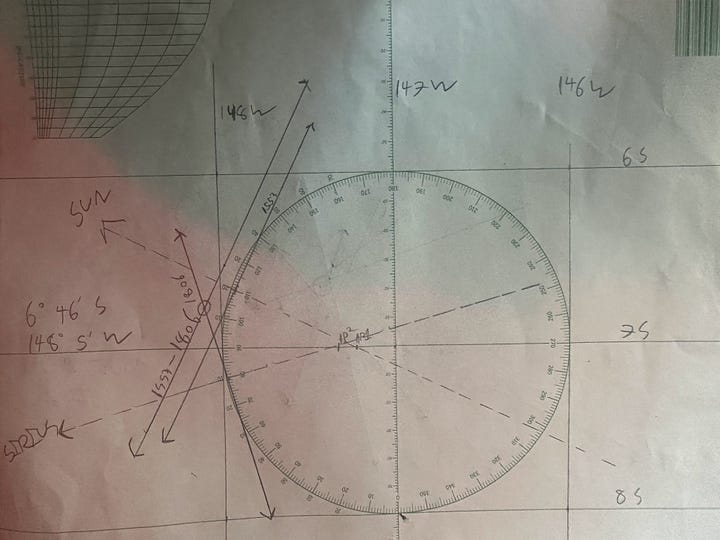
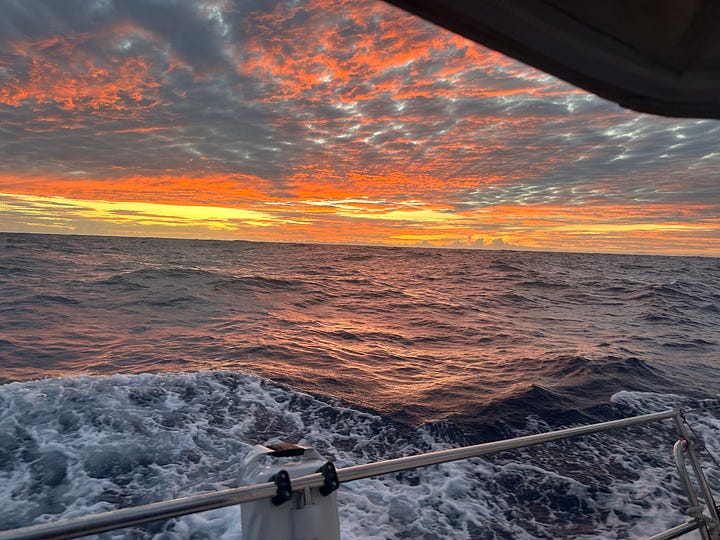
More than you want to know about celestial navigation
May 23, 2024
4°21’S 148°23’W
As of 1800 yesterday evening. I went crazy and shot every star I could identify. I wanted to see how accurate I could be, so I took sights on Spica, Canopus, Arcturus, Sirius, Pollux, and Alioth. I operated the sextant. My brother read of the time (you need to record time to the second). And my father read off pre-calculated positions for the stars and recorded the time / sextant readings. It was fun and beautiful to do. I peeked at the GPS so we could judge the accuracy. GPS reading was 4 20.0S 148 21.9W. So we were about 2.5 miles off. That’s about as accurate as celestial navigation at sea can get, so good job us!
Skip to the end now if you are not interested in the history of celestial navigation!
Eratosthenes was the first person to measure the size of the earth (whether before or after his sieve fame I don’t know). He did this by measuring the angle between the sun and the ground in two cities simultaneously (I believe he measured the length of the shadow cast by a fixed-length pole in one city, at a time when the sun was known to to pass directly overhead in the other). His insight was that because the sun is far enough away that all light rays reaching the earth are essentially parallel, the difference in simultaneous sun angle between any two locations tells you how much the earth arcs between theses locations. So, to estimate the circumference of the earth, all he had to do was take the surface distance between the cities in miles (perhaps stadia?) and multiply this whatever percentage of a circle of arc he had measured.
No one is sure how accurate his result was, however, because apparently there were a bunch of different definitions of “stadia” in use, and he never clarified which he was using!
Celestial navigation uses the exact same idea. Eratosthenes used a measured angular difference and known surface distance to calculate the size of the earth. Navigators use a measured angular difference and a known size of the earth to calculate a surface distance.
Tables in the nautical almanac let you look up the position (think lat, long) of the point directly under a given star for any second in the year. Then, you measure the angle to that star with a sextant. Finally, you multiply to get your distance from that point. That is, you get a larger circles with a known radius. Your position falls somewhere on this circle. Repeat this a number of times and where all the circles intersect is your position.
An interesting historical note is that this is not actually how sailors thought about celestial navigation throughout most of the age of sail. The process above requires an accurate clock and access to trigonometric tables (I did not mention trig above, but it takes trigonometry to calculate and accurately plot a small portion of the circles of position mentioned above). This process was invented by a French caption in the 19th century (Saint Hilaire). Before that, sailors only computed latitude by much more straight-forward sights on Polaris or the sun at local noon (and the celestial almanac only listed the latitude of the sun by day rather than by second).
It is actually posible to do accurate celestial navigation without an accurate clock. Joshua Slocum did this (at the time, chronometers were expensive). You do this by taking advantage of the fact that the moon moves independently over the stellar background. Thus in some sense, the moon’s position relative to the stars behind it is an absolute clock. Practically, the way to do this is to first take a star fix on a bunch of stars using an inaccurate clock. The clock has some unknown error, and this will shift the latitude of the point where the lines of position from the stars cross. But if they were all shot with the same clock, they should be internally consistent (all have the same longitude error). Next, take a sight on the moon and plot this line. Because the moon moves at a different rate, it will NOT be internally consistent with the stars. The line of position from the moon will pass through the same point as the star fix only if the clock is correct. It your clock is fast, the moon line will be west of the star fix. Of your clock is slow, the moon line will be to the east. From that offset you can calculate the clock error.
In a wonderful mashup of modern (Apollo program) mathematics and age-of-sail technology, I suppose the best way to do this would be to use a Kalman filter each day to update your estimate of clock error. That would be wonderful! I want to program that.
Anyway….
Today is our 7th day out of Tahiti. I’m going to make molasses and ginger cake to celebrate. Dinner will be tuna mole (we’re still eating the 40-lb tuna we caught weeks ago. 40 pounds is a lot of fish). The wind has been excellent. Sometimes, adjusting the sails can be tiring. You only just finish putting in a reef before the wind drops and you need to shake it out to keep moving. You put work into getting a good low-turbulence trim on the mainsail and jib, and the wind angle changes. You pole-out the jib, but lose more time on the foredeck rigging the pole than you gain in speed. Other times, the boat is magic. You trim your sails once, then a steady wind takes over. You zoom over the water. A force of nature. You can’t be stopped. This has been us for the last 36 hours.
-Ammon
Food
May 24, 2024
1°44’S 148°50’W
Running fix on the sun and Arcturus as of 1830 yesterday. We’re getting close to the equator! I expect to cross at 4 or 5 this afternoon. We have a bottle of pineapple champaign from Tahiti (oddly, given that it’s pineapple champaign, it was not cheap). I think we’re going to open our watermelon as well.
Last time we crossed, none of us had been across before. This time, my brother Gurney is with a couple of weathered shellbacks. The hazing might be fierce.
So, today I’m going to talk about food! What are we eating during a crossing on a sailboat?
The first consideration is just having enough calories. I expect it to take us around 17 days to sail from Tahiti to Hawaii. However, we want to have food for at least double that time. If we lose our mast, say, and are limping in under a jury-rig, we might only make half the speed. Additionally, while we have a fridge and propane stove/oven aboard, either of these systems could break (as you know, the fridge has been trying its best to do just that), so we need enough calories that don’t require cooking or refrigeration. So planning started with a spreadsheet where I tracked the caloric value of each item and whether it needed cooking / refrigeration. To hit our goal (2000 per day, 3 people, 34 days = 204k calories) there’s a lot of nuts, peanut butter, oil, canned meat, and granola (we left SF with 35 pounds of granola). I’m not worrying about nutritional balance in any emergency case.
After the emergency case, it’s just a matter of what we will enjoy. I think food is important. And it’s a small % of total gear weight on the boat. So we have a full rack of spices, cheese galore, pickles from home, tofu, eggs, beans, couscous for days, quinoa, chocolate, coffee, shelf-stable milk and fruit juice, a sparkling water maker, chili crisps from a friend, popcorn and nutritional yeast, butter, home-canned jam. We packed just about every good thing we could think of. Were you imagining us out here, austere sailors, living on hardtack and tinned fish? I hope you’re not bothered we’re making whipped cream for our molasses / ginger cake (made with real vanilla and both fresh AND crystallized ginger) and Alison-Roman-cauliflower pasta?
The only real constraint is fresh fruit / vegetables. We stock up on departure, and they last pretty well. We left Tahiti with 15 lb of bananas in a net on the back of the boat. They all ripened last week. We faced intense banana pressure. But Bartram men do not give in before a fruit-based challenge, and we prevailed. Now we’re contending with pineapples and mangos. The pamplemousse are hanging back, biding their time, planning their final charge. Ours is not to reason why. Ours is but to do and die. Onward, rode the pamplemousse!
The other factor is cooking. Yes, the kitchen is fully functional. But it’s also heeling by 30 degrees, sometimes 90 degrees F inside, and bucking over the waves. The stove is on a gimbal and the pots clamp to the cooktop. This works better than I would have predicted. So it’s almost always possible to cook. But, somehow, I don’t always have my normal enthusiasm. Hard mode is when we’re sailing downwind large waves and the boat can heel sharply in either direction. Nothing stays where you put it. For really hard days we have what we call storm food—meals that don’t require cooking for when the kitchen is too dangerous.
We’re washing dishes now in saltwater (without even a freshwater rinse). This works just fine, it ends up.
All in all, we eat well—better than on the boats where I crewed in preparation for this.
-Ammon
Addendum
My brother has fleshed out “The Charge of the Pamplemousse”
Squalls to the right of them
Squalls to the left of them
Squalls in front of them volleyed and thundered
Stormed at through rain and gale
Boldly they swam and well
Into the jaws of death
Rode the pamplemousse
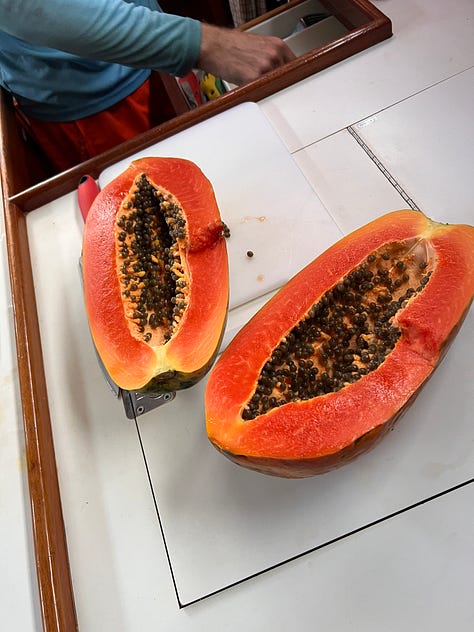
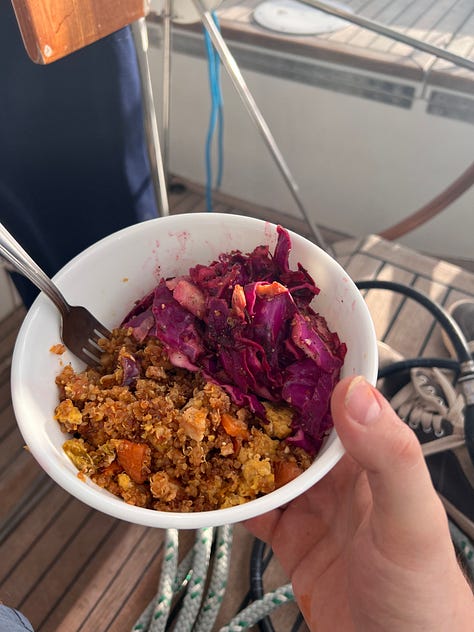
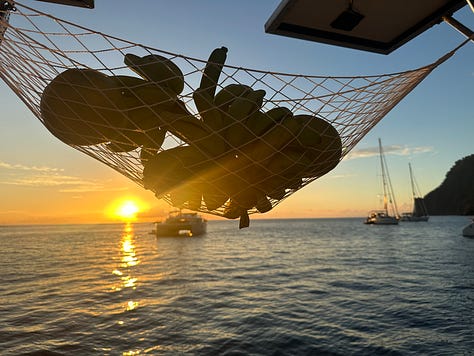

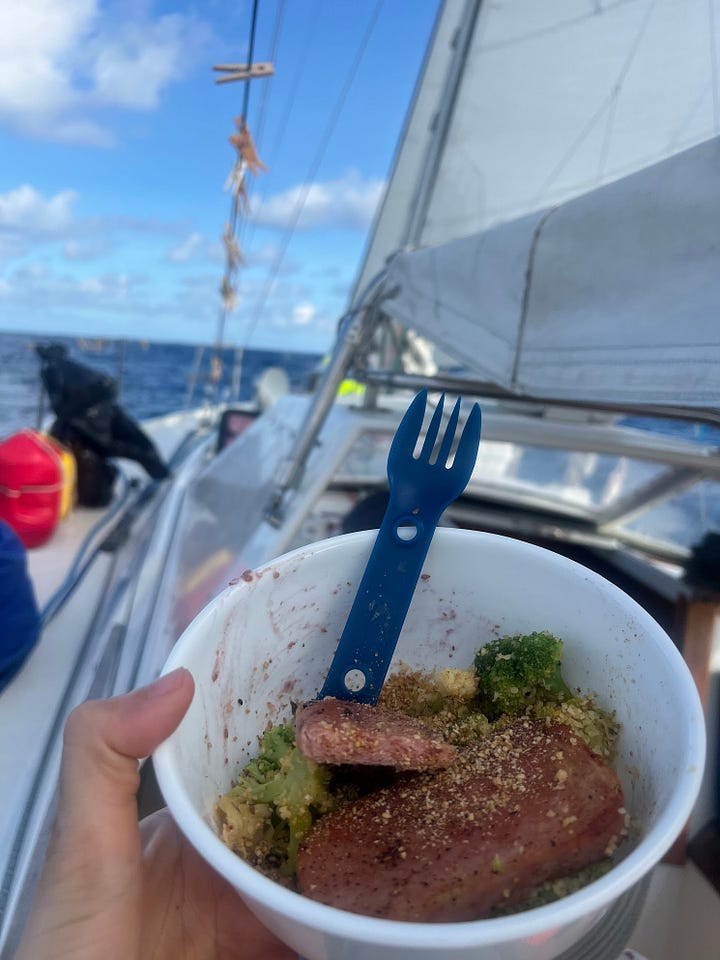
A trans-equatorial stowaway
May 25, 2024
1°30’N 148°30’W
As you can see in the “N” above, we crossed the equator! My brother is now a shellback. It was a beautiful, entirely clear day. The wind shifted to the south, so we were able to get the spinnaker up and cross the line in style right as the sun was setting. The Tahitian pineapple champaign was… interesting. I think it really was wine made from pineapple juice (not regular wine with flavor/juice added). It was quite crisp and dry, with a pronounced bitterness. In any case, the pineapple wine flowed and Neptune got his share.
After dark, we conducted a much-needed crew training exercise. As we announced over the VHF so any nearby ships would not think we were in distress, this was a planned pyrotechnic training. We definitely weren’t just firing (expired) parachute flares every-which-way to celebrate the equator. What kind of captain wound allow that?! We returned to the northern hemisphere with pineapple spirits and parachute signal flares.
When my brother Gurney was 4, he loved playmobile (sp?) the plastic figurine brand. So when our father’s birthday came along, 4-year-old Gurney gave him one of his figures (a small monk with a traveling bundle on a stick). My father is a genius with kids games, and came up with the idea of leaving the monk figure in different positions around the house, engaged in various activities. One day we’d find the monk holding up a flower on the kitchen table. Another day, we’d see the monk carrying food to the fish tank. We took delight in finding each new monk-ish scene.
When we were teenagers, we pulled off a traveling monk coup, by bringing him along (without our father’s knowledge) on a climbing trip to the Tetons. We stole our father’s (film) camera and snapped a photo of the monk on top of one of the mountains. Father only learned about this weeks later when he developed the film.
Well, the traveling monk is now aboard Little My! He seemes to have stowed away. We’ll deal with discipline at the next port of call, but for now I’ve given him a berth in the lazaret put him to work re-caulking the deck. He was at the wheel as we crossed the equator.
The ITCZ (the area around the equator with low wind, sometimes called the doldrums) is north of the equator right now. We’ll be in it for the next day and half. However, I think we’re getting lucky again (recall that we had 30-knot winds in the ITCZ southbound). So far, the wind is great (15 knots steady on our starboard aft quarter). Since leaving Tahiti, I’ve focused on staying far enough east to avoid an up-wind approach to Hawaii. Well, we did it. We have a good angle. As soon as we exit the ITCZ and enter the regular trades, we’ll make straight for Hawaii (should be 235 degrees true, with wind on the beam).
Trouble is, I still don’t know where we’re going in Hawaii. I’d love to get a space in a marina (fresh water to clean salt off the boat, easy access to shore for my father, a weight off my shoulders after months of always having to worry about the boat in the back of my mind).
I called several marinas in Honolulu before we left, but none would take reservations that far out. I’m now undecided between heading for Honolulu (where the most marinas are, but where anchoring options are not very nice) or Hilo (no marina at all, but simple anchoring). I’d actually be ok going anywhere in Hawaii where we can get a marina reservation. Nurcan is helping with this, but she did just leave for Turkey. If it does not work with the phones / time to call from there, I might ask for a volunteer to help.
-Ammon
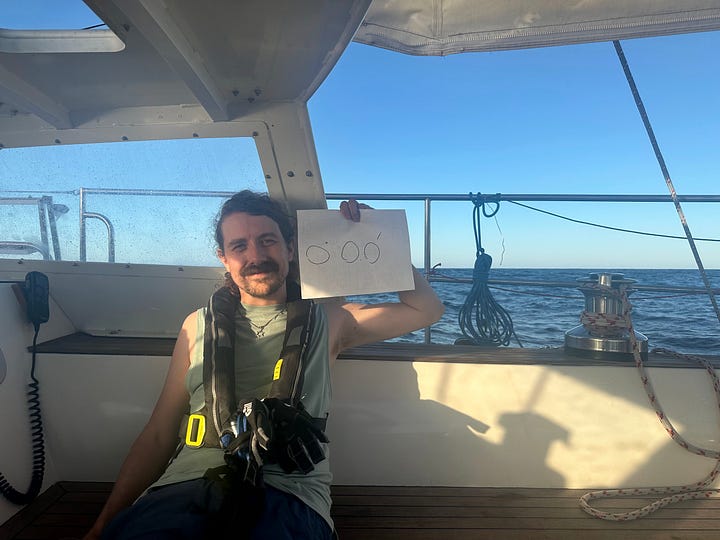
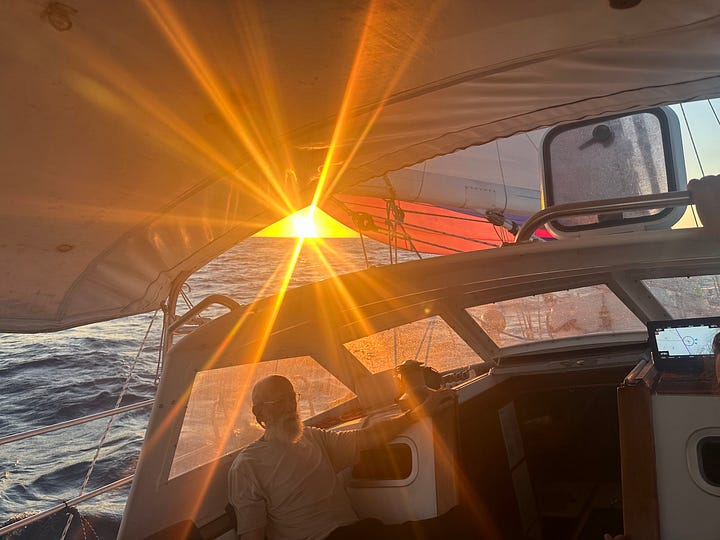
The stars acording to Stuart
May 26, 2024
2°40’N 148°20’W
Fix on Spica, Canopus and Sirius as of 1830 5/26. Our barometer is broken (either that, or we’re headed for the strongest hurricane ever recorded). It now reads 0 millibar.
Today, we have a guest update! My father asked to write something here. He’s an early riser. Just about every morning during my childhood, he’d wake before light, make coffee, touch up his pencils in his special sharpener (not for kids), and write in his journal as the sun came up.
He’s kept up this habit on the boat. Yes, we’re standing a watch schedule so the writhing can’t always happen at sunup. And yes, he’s had to make do with dull pencils and a coffee cup jammed into a plastic bucket to stay upright in waves. But every morning, my father writes. The following was written by hand in pencil with block script on a yellow legal pad.
—
Ammon suggested I write something about the stars. They’ve accompanied us. They’ve even told Ammon our position on the sea. We might not look forward to the weariness of night watches. But every one of my six mates has spoken of the wonder of the night skies. When my boys invited me to sail to the South Pacific with them, one of my first thoughts was that I would see the southern stars! Yes, I’d go! All my life, I’ve wanted to see the Southern Cross. And I’ve seen it now. When grandson Rio was with us and we sat together under the stars, he remembered my giving him as a Christmas present, when he was little, the promise of taking him to see the Southern Cross some day. Bam! His telling me this was a gift back to me. Canopus, Alpha Centauri, Fomalhaut: I’ve seen them now. And I’m grateful for it.
Last evening, I showed my boys that from the handle of the Big Dipper you can “arc” to Arcturus and then“spike” to Spica. I believe my own father showed that to me. There’s story and tradition in the stars. Now there’s some of this trip in them too. We’ve returned to the northern hemisphere and are on the lookout for Polaris.
-Stuart
A quiet place
May 27, 2024
5°30’S 148°30’W
Dead reckoned (DR) position as of midnight, 5/27. I failed to get sights for a fix last night because I was baking brioche (on the positive, we had fresh brioche with dates and mascarpone yesterday).
We passed the halfway point between Tahiti and Hawaii. We’re about 1100 nautical miles from the closest land (ignoring Christmas Island, 500 miles downwind). We are in the middle of the Pacific.
Weather has been unsettled and squally for the last 24 hours. This was the ITCZ—lashing rain and 25 knots from the south one minute, a gentle 10 from the east the next. However, as of 3 hours ago, I believe we are in the northern trade winds. 16 knots from the west northwest, steady and true. These are the winds that will carry us to Hawaii.
A sailboat underway is not quiet. With 10 knots of wind and 3-foot waves, the sounds are muted—a rush of water against the hull, the light slap of waves. The boat is full of equipment—the whirr of the fresh water pump, the thump thump thump of refrigeration, the click click of the steering vane. A mast with taut rigging attached to a hull, you see, is basically a string instrument. We live in the amplification chamber. Even at 10 knots, there is a baseline hum.
At 15 knots (3 to 4 foot waves) the intensity doubles. To the hum of the rigging, add sharp cracks as lines in the wind impact the mast. The volume increases. Creaking and groaning begin. Once a susurration, the water against the hull moves into the light roar category. This is especially true as the boat crests a wave and slides down the far side.
At 20 knots (5 to 6 foot waves), it’s loud. The shrouds have become a string symphony. It becomes natural to worry: is the rigging going to hold?
At 30, you better have your sails in trim. If a sail luffs at 30 knots, it has the percussion of a gunshot (it is also dangerous to anyone in its path).
At 40 knots (the most I’ve experienced at sea) it’s just funny. There is complete overstimulation. Every joint in the boat seems to make a sound. As long as you have postage stamps for sails, you are actually still fine. But it sounds like you’re in a demolition derby.
I have to pay attention to these sounds. A number of times on this trip already, I have discovered a serious problem because something did not sound right. The tap-tap-tap in the lazaret was one side of the windvane mount coming free from the boat. The unexpected whirr was water leaking out of our gray water tank and triggering the bilge pump. The low rumbling was the engine of another boat (not on AIS and missed by our watch keeper). Because of this, I chase down every errant sound.
Most often, however, the new sound is something surpassingly small (a single cup, an emergency whistle) loose in a locker, banging on the hull as we roll. I fix these too, stuff them in place with a bit of paper or tape. Then I go back to sleep.
-Ammon
Cup-O-Fish
May 28, 2024
7°21’N 149°30’W
Fix on Acrux and Arcturus at 1850. We’re zooming north in heavy conditions. It was hard to take the sights. I need my body braced where I can let go with both hands (to operate the sextant) and also enough movement of my upper body to counteract the roll and keep the star in the scope. I had to find ways to wedge my knees against the structure of the boat. And every few minutes we were taking waves over the deck. My sextant is in need of a freshwater rinse.
Flying fish are back in force. Yesterday and today we saw huge flools of them all taking off in unison. We’d not seen that since the Marquesas. Yesterday, one of the fish landed on my father’s empty coffee cup (in a cup holder in the cockpit). We found it today while tidying up. What phenomenal bad luck for that fish!
It’s blowing 22 knots right now, gusts above that, waves are approaching 9 feet. I wrote about what that sounds like yesterday. I’m alone in the cockpit on night watch. The sea is beautiful but threatening. My god I don’t want to end up in that water. I can’t see the waves before they crash into us, except occasionally there’s enough bioluminescence to make out a glowing crest. I’m hiding under the dodger and I mostly stay dry here. Buy every few minutes, I have to poke my head up into the maelstrom to get a good look forward.
Little My has at-mast slab reefing. This is the simplest and most traditional way to reef sails on a boat (reduce the size of sails in strong winds). It was what I wanted when shopping for a boat. Simple is reliable. However, it means that to reef the sail, I have to go forward to the base of the mast to hook a metal loop on the sail (the cringle—everything on a boat has a name) over a hook (the ram’s horn). We have lines rigged that I tether myself to, so I am always attached. Still, this involves crawling low over the pitching deck, in exactly those conditions where you might not want to do that (when we have more sail up than we want). I certainly see the argument for other reefing systems!
Most new boats today have in-mast furling for their main. In this system, the mainsail rolls up vertically (just as our genoa does). It’s convenient. To reef, you just roll the sail in part way from the safety of the cockpit. If you have a power winch, you just press a button. However, an in-mast furling sail can’t have battens (flexible fiberglass strips inserted into pockets in the sail). Battens are sanded to precisely shape the airfoil of a sail, and they allow the sail to extend out past the simple triangle between the mast and the boom. So an in-mast furling sail is smaller and less efficient. I can’t have that! I want my archaic transportation technology to be as efficient as possible. Also, I do actually enjoy harnessing up and venturing out onto the foredeck to reef. I’m careful, but it’s fun.
-Ammon
My father the adventurer
May 29, 2024
11°N 152°W
DR as of 0530 5/39. The only stars I could shoot last night through the clouds were Arcturus and Sirius which fall almost 180 degrees apart. This means the lines of position (LOPs) would be near parallel and not give an accurate fix.
We’re sailing through big waves right now. I have the storm jib set. We’re a little under powered (making 6 knots). But I’m trying to keep the boat calm.
My father has fallen several times in the last few days since we’ve been in rough conditions. He is so far uninjured (beyond a nice bruise on his shoulder). However, with every fall, there is a risk of a broken bone or major injury. As far as we are from help (and given his age—77) this would be a major disaster.
Living on a pitching and heeling boat is hard. As the boat heels, horizontal space (the beam of the boat) opens up. There’s a 4-foot gap between the galley sink and the nav station, a 3-foot passage outside the head, 6 feet across the cockpit. Add in 25 degrees of heel and these spaces becomes voids waiting to consume a dishwasher who makes one false move, someone stumbling out of the head at 3:00 am, a watch keeper standing up at just the wrong time. It’s not that hard to stay safe in any one instance. But we’re living on the boat 24/7. So the odds of a mishap compound.
Gurney and I have the strength to hold on with a single hand if need be and the reaction speed to almost always find a way to catch ourselves if something goes wrong. My father is 77. He has a tremor. His grip strength is lower and his reaction speed is slower. He’s not always able to catch himself.
In the 1970s, my father rode a horse across Afghanistan. He is an adventurer. He climbed rock faces in the Tetons before the invention of the belay device. He hikes mountains in the Adirondacks alone, at night, without electric light (finding the path by moonlight). As he’s gotten older, the mountains have gotten smaller, but he still does it. This was why my brothers and I invited him on this trip.
But the falling is too dangerous. It has to stop. So, we’ve decided that as long as the wind remains above 15 knots, Stuart is not going to cook / wash dishes / make coffee / do anything that places him at greater risk. We’ll do those things for him.
This is not easy for Stuart. I can tell it’s important to him to feel useful on the boat. He does not have a lot of experience sailing, and he’s been feeling useful by doing more of the cooking/cleaning/general work. Now I’m taking that away from him. This connects to aging as well. It’s the first time we, his kids, have told him “don’t do that, you’re too old, let us do it for you.”
It is a joy to get to go an adventure like this with my father. Him reading us books about Shackleton and Slocum (and the Swallows and Amazons) has a lot to do with why we’re here. If you’d asked me a few years ago, I’d have said it was unlikely we’d ever take on an adventure this large together again. He is brave for being here in any capacity. You should see how some people react to learning he’s doing this. And he’s still standing solo watches! This is impressive. I wish I could get him to see himself here the way that we do.
My father has read and approved this email.
We’re about 700 miles from Hawaii. Winds are forecast to stay strong. I expect to cover that in 4 to 6 days.
-Ammon
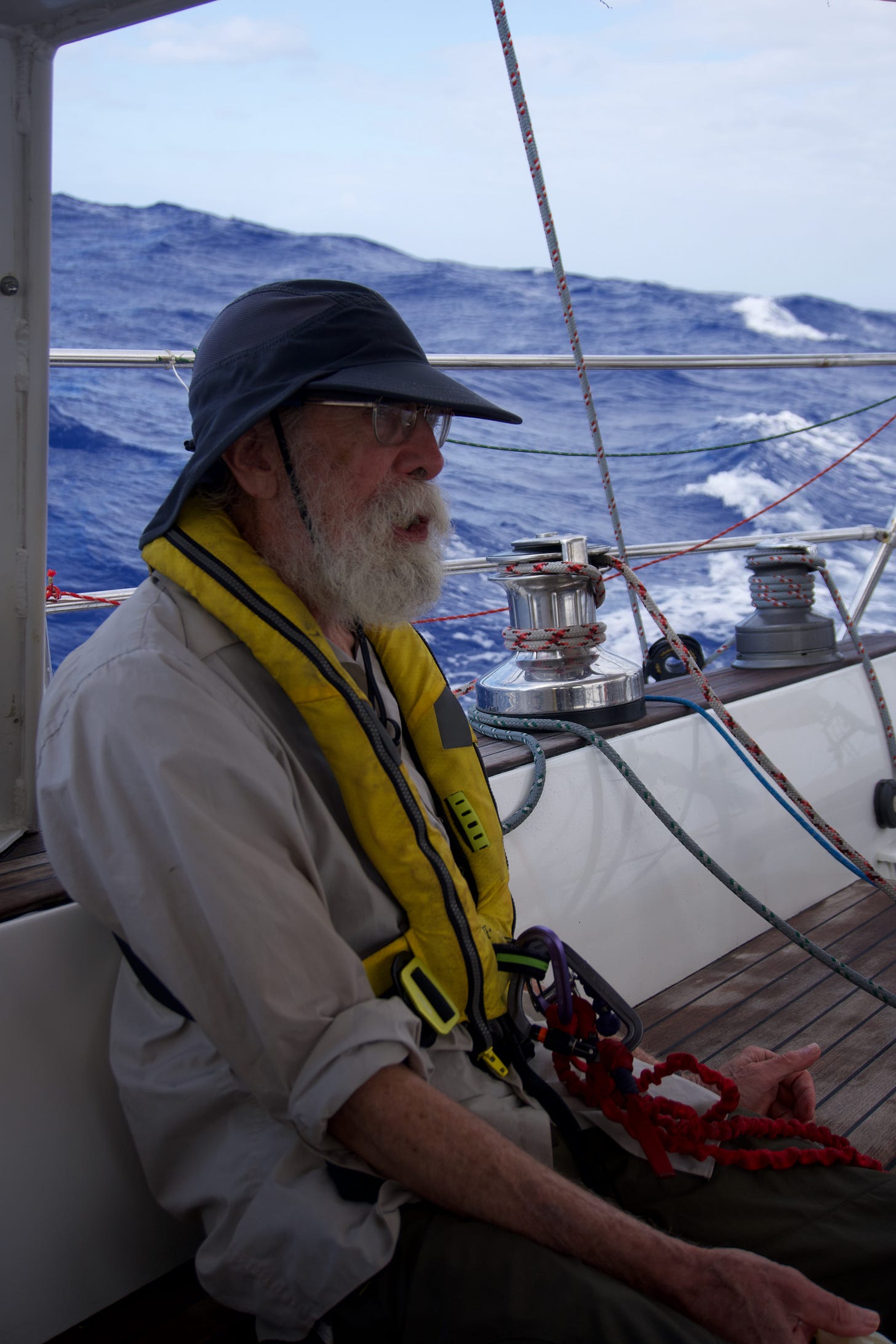
Everything is damp
May 30, 2024
12°50’N 153°W
DR. No stars visible at twilight. I need to take sun sights tomorrow. On all but the most cloudy days, it’s possible to get in a sun-run-sun fix.
Wind is still 20 knots, sea 6 feet. We’re under doubly reefed main and roller furled genoa. We had the storm jib up earlier, but we needed a little more canvas to make headway upwind against these waves so I swapped it out for a heavily reefed genoa. We are making the course to Hawaii, but only just. The problem is current. Our wind angle looks fine on paper. But add in a 2-knot east-to-west current, and we have to point high to make it. The current is fluctuating, so sometimes we’re on a happy beam reach, other times a close haul.
The boat is feeling warn. I guess this comes with the long up-wind passage. Stitching is coming loose along the genoa’s trailing edge. I *think* it’s just the UV cover that’s damaged. If it gets much worse, I’ll attempt a repair underway. I have supplies to do this, I just don’t want to remove the sail on these conditions.
The genoa furling line is showing chafe damage. I could not find where it’s rubbing (it’s funny how hard it can be to find the source of chafe). I swapped the line end-for-end to buy time (I do also have a spare), and I’m checking it every 12 hours. (Were the line to fail, we’d suddenly find ourselves with full genoa. Not fun in strong wind.)
There’s a sporadic clicking sound coming from the steering system. I looked at this briefly last night. I think it’s a lack of lubrication on an auxiliary part of the system (perhaps the rudder angle sensor). It’s on my todo list to try to fix this today (I don’t like any question marks about the steering system)
We have two persistent deck leaks now, both in the bow. There’s no danger here. But it is a quality of life issue. After a period of aggressive weather on a sailboat, everything gets damp. There’s a sheen of salty, sticky moisture covering the floor of the boat. Because salt is hydrophilic and salt is everywhere now (deeply soaked into my hands and feet, my clothing, my pillowcase) the dampness creeps upward. We need a bright sunny day with no spray so we can open all hatches. Based on the forecast, this might not come until Hawaii.
We have a bunch of fruit left that will be confiscated in Hawaii. I’m a believer in metric-driven leadership, so we’ve identified a KPI and put in place an OKR. PPD* > 2. It’s a team effort.
-Ammon
* pamplemousse per day
Since I left Plumtree back in Tennessee it’s the first time I’ve been cold
May 31, 2024
15°36’N 154°21’W
400 miles to go to Hawaii! We’ve sailed a total of 6800 nautical miles since leaving San Francisco in March. So we’ll clear a nice round 7000 by Hawaii.
I made pancakes and marmalade for breakfast this morning. The sky was blue. That by itself does a lot for morale. The wind moderated a bit around midday and we all bathed in the cockpit. The boat has a small shower compartment attached to the head (marine toilet). However, I don’t think the shower stall has been used a single time during this trip. Rather, we sit in back corner of the cockpit, scoop water in a soft canvas bucket, and pour it on ourselves as the sea zooms by. It’s the most beautiful shower.
It was cold last night! I’m wearing my foul weather gear as I type this. For the last 2 months, we have existed in a state of uninterrupted heat. Sweat has been the constant. The 12- volt fans make it bearable at night, but at no point could I countenance any sort of top sheet or (god forbid) blanket. Well, last night I woke up cold!
Interestingly, the trip north has been significantly less hot than the trip south. We crossed the equator south-bound just after the spring equinox. This means that we passed directly under the sun as we crossed the line. And it was HOT! This time, it’s northern hemisphere summer. The sun is around 21N. So despite the fact that we crossed the equator 1000 miles ago, we’re still actually sailing towards the sun. I was not sure if the equator would be the hottest point, or if heat would rise all the way to Hawaii as we approached the sun. I guess it’s a question of how much air temperature is determined by short-term solar angle vs all-year average. Well, the hottest point was the equator, but it was less hot than when we came south. And ever since, it’s been cooler every day. We’re loving it. It’s a Sam McGee situation.
-Ammon
Addendum
My brother has fleshed out “The Refrigeration of Sam McGee”
There are strange things done
Neath the tropical sun
By the Bartrams who sail the globe
Even passing whales
Tell secret tales
That would make your blood run cold
The bioluminescent lights
Have seen queer sights
But the queerest they ever did sea
Was that night on Little My
Beneath overcast sky
When I refrigerated Sam McGee
Land ho!
Jun 2, 2024
18°36’N 156°13’W
Back to GPS navigation as we approach the island. We’re 40 miles off the cost of the big island, 190 from Honolulu. But we just called “Land Ho!” There’s some prestige in being the first to see land. But we were all unsure enough that we debated for 30 minutes before Gurney made the call.
We’re sailing fast… 7.5 knots in 23 of wind right now. It’s wonderful to get to land after a passage. However, we still need to cross the archipelago. We’ll arrive tomorrow afternoon. But if I don’t have at least a few hours of light to navigate the harbor, we’ll have to anchor outside the harbor (or heave to further out). I hope not, but we’ll see.
I’m making celebratory Mac and cheese tonight.
Yesterday, we held a traditional maritime egg and spoon race. The course was from the v-berth to behind the wheel. Only one egg was injured!
My brother and father will fly home from Honolulu. I’ll work on the boat for a week (plenty to do). Then my other brother Eli and his family will join and we’ll cruise Malaki.
-Ammon
Safe in harbor
Jun 4, 2024
We are safe in a marina in Honolulu! I showered in running fresh water for the first time in months.
We had some exciting last minute breakages. I did not send an update here yesterday because… our satellite modem stopped working! We have an emergency backup, so I was able to get a message to Nurcan and Eli that we were ok. But I had to sail the last 36 hours without weather data. On top of that, the ships wheel (the steering wheel) fell off*. I’m not joking. This is of course easy to fix (there’s just a central bolt that holds it in place). But it felt symbolic. The wheels are coming off the ship! Travel weary, Little My and her crew made landfall. Time for rest and repair.
The entry into the marina here was incredible. It’s squarely in the middle of the city (ringed by skyscrapers). And the narrow channel in starts on Waikiki beach (famous for surfing). So you have to sail toward marker buoys with large breaking waves and actual surfers on both sides of you. It was dramatic.
*The nut that holds the wheel on was obscured by part of the windvane, so we could not easily inspect it underway. I knew this (and tightened it before I let SF). But I clearly need to add inspecting that nut to my weekly checks.
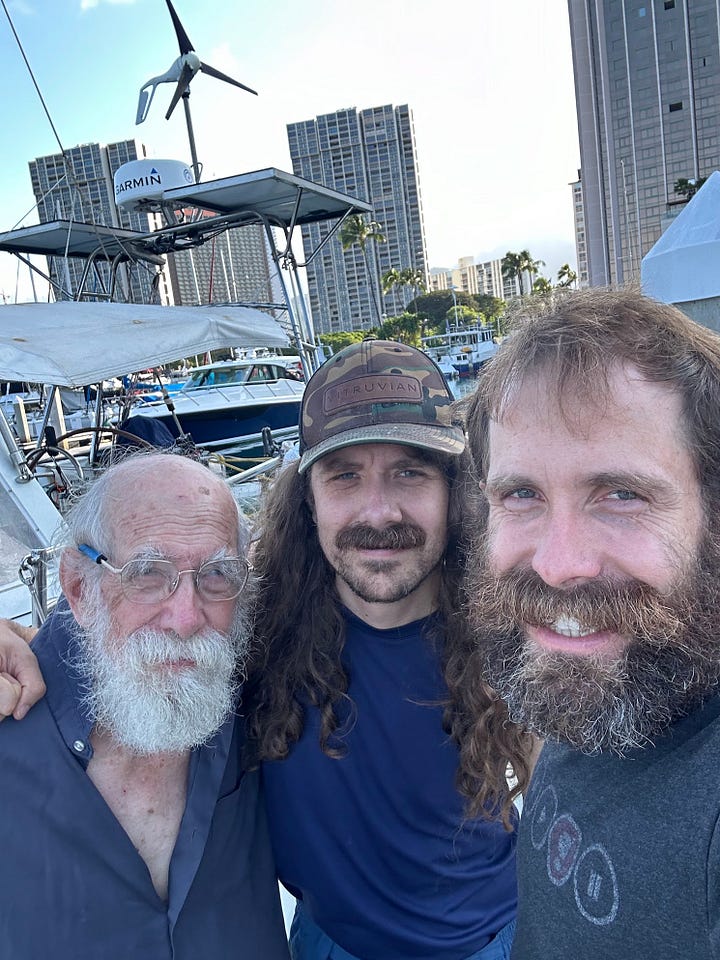

Repair + videos
Jun 9, 2024
We’re still docked in downtown Honolulu. I’m backed by the glow of hotels and apartment towers as I write this. Gurney flew home. My father and I have been hard at work repairing and clearing the boat. It’s nice to just rinse off the salt with fresh water.
The problem with the autopilot turned out to be low hydraulic fluid. The genoa is at a sail loft. My brother Eli will bring a new Iridium when he comes next week. The broken part on the boom had been ordered. I re-mounted the solar panel that blew off (and reinforced the other one).
I did also discover damage to the lower fitting on the baby forestay. Luckily, I can fix this without too much trouble (cut off the damaged fitting and install a new one with an extra-long stud)
In the meantime, I uploaded a video of my father!
-Ammon


